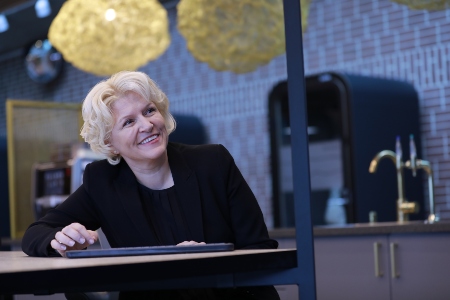Panel of Successful Women Leaders in the SAPinsider Community Discuss Diversity and Inclusion
by Lauren Bonneau, Senior Editor, SAPinsider
Kicking off the SAPinsider 2020 conference, the opening keynote featured a powerhouse group of women leaders from the SAPinsider Community who addressed the importance of organizations creating a culture of inclusion and diversity. The panel included Anthea Stratigos, Co-Founder and CEO at Outsell, Inc.; Alison Biggan, Chief Operating Officer, Marketing COEs and Operations at SAP; Mervi Lampinen, Senior IT Executive at MSD; SAP’s Judith Williams, Head of People Sustainability and SVP, Chief Diversity and Inclusion Officer; and Ada Salas, Director of IT Process Owner for Manufacturing and Supply Chain at the Merck Group.
These strong and eloquent women leaders fielded questions regarding existing problems holding women back from attaining and retaining positions in the fields of science, technology, engineering and math (STEM), and talked about how individuals and organizations can change the status quo. Drawing on their own backgrounds and experiences, they offered advice while discussing their individual journeys. For example, Lampinen credited her ability to stay resilient in a challenging industry for women to having a very supportive father who fostered her interest in technology with game-like enthusiasm (while teaching her how to change tires and take apart/reassemble radio components).
Explore related questions
Each panelist agreed that having a supportive and encouraging presence of someone inspirational to turn to is a crucial success factor for women. According to Biggan, this goes beyond just having role models inside and outside the organization but rather having senior leaders being advocates and staking their own reputation on another’s success. “Women tend to be over-mentored and under-sponsored,” she said. “You have to earn sponsorship — not only with your work, but by putting yourself out there. Everyone who has been successful has someone who sponsored them.”
Salas acknowledged that more workplaces are already becoming more diverse, but that creating and embracing that inclusion and ability to understand other people’s views will be a key differentiator to breaking down barriers and stereotypes. “We are looking for those role models, but one does not fit all,” she said. “So we need a diverse portrait of what a women leader looks like to motivate emerging leaders.”
Williams added that organizations need to be accountable for bringing women in — and keeping them. “It’s important to have a holistic view, starting with recruiting,” she said. “We shouldn’t hire the best person for a role but the best person for a team, and we need to have a diverse mix of skills and competencies for the best team.”
One way to achieve this, as Biggan suggested, is to put in technology that removes conscious or unconscious bias from the hiring process and throughout the employee experience. She added that a company’s diversity should reflect the diversity in the world and getting there requires a commitment from leadership to reflect back — setting targets and challenging people to meet them, and putting policies in place that encourage flexibility for employees. “We need to challenge the status quo,” she said. “All the times we feel comfortable, we need to take a pause and question if we are just doing things the way we always have.”
Organizations can create a culture where everyone can thrive by setting measurable targets to close experience gaps, according to Williams. “Think about diversity inclusion as a business challenge, and measure it with the same rigor,” she said. “When you have a data-rich metric-driven approach and put it in a language than makes business sense (promising validated measurable outcomes), it’s easier to convince people to buy into the idea of inclusion.”
Salas recommends that women who are interested in leadership in technology take the time to create a long-term plan and continually visualize its goals, and crucially important is to communicate — because it’s a dead end trying to do it alone. Lampinen agrees, “Women need to be inclusive in their own behavior of letting other people help. We don’t have to control everything or take all the responsibilities on ourselves.”
To hear more of their insights, keep an eye out for the recording of the keynote, which will be available here shortly. And be on the lookout for upcoming Q4 edition of SAPinsider magazine, which will showcase the theme of “Women Leaders in Technology” and will highlight more from these amazing women leaders — and more.








